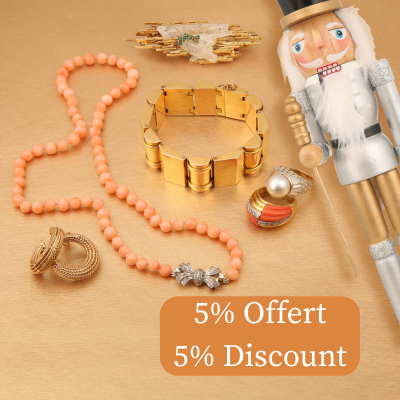Animals in Jewellery: Metal beasts with shiny eyes and fur

Jewellery has always been inspired by nature, and in particular by the animals we encounter in our daily lives.
In this article, we take a look at the trends, implications and beliefs that have transformed some animals into jewellery over the centuries.
Prehistory :
As far back as prehistoric times, man began to depict animals in jewellery in the same way as he did in cave paintings. By 10,000 BC, they were no more than rather crude bone pendants, but they were already laying the foundations for a genre that would become timeless.
Antiquity :
Many pieces of jewellery featuring animals were made in ancient times, mainly for prophylactic, ritual or good-luck purposes.
Among the main cultures use to depict animal motifs in their jewellery was Greece, whose favourite animal was the snake.
The snake was well known to bring good luck, and was directly linked to the god Asclepius, whose staff on which a snake hung cured illnesses.

Bronze and gold bracelet with snake motif, 300 / 200 BC, Corinth. © 2001 RMN-Grand Palais (Musée du Louvre) / Hervé Lewandowski

Gold snake bracelet - 1st century BC © Musée Benaki Photo : Sandrine Merle
On the other side of the Mediterranean sea, Egyptian culture is not to be outdone, but the subjects will be manifold. Indeed, the Egyptian polytheistic cult was made up of a majority of zoomorphic and anthropomorphic gods, including, but not limited to, the following:
- Thot, the Ibis-headed god of scribes and knowledge
- Sekhmet, the lion-headed warrior goddess
- Anubis, the jackal-headed god of embalmers
Many of the symbols derived from these gods and their animal attributes were used in jewellery design. Although the finest examples of this jewelleries were found inside the tombs of the Valley of the Kings or the Valley of the Queens, we know that it was common among the population itself.

The Uraeus cobra of the goddess Ouadjet, protector of Lower Egypt, and the vulture of the goddess Nekhbet, protector of Upper Egypt, are two animal representations found on many pharaohs' crowns.
Middle Ages :
In Scandinavia, Viking myths influenced jewellery design by incorporating numerous animals from the sagas. High-quality metal objects were made with snakes' motifs, eagles, ravens, wild boars, rams and dragons. The snake, a symbol of wisdom in their culture, was also a reminder of Jormungandr, the giant serpent surrounding the world and preventing the oceans from draining.

Urnes buckle with dragon, from Sør-Fron vicarage. Photo: Ellen C. Holte, Museum of Cultural History, University of Oslo.

Half human, half wild boar. Eagle heads are seen on each side of the man's face, and two eagles form the belt itself. Belt buckle from Åker in Hedmark. C4901
In Christian cultures, animals were also used as models, but obviously without the pagan considerations. Instead, each animal was considered to have a particular Christian value, such as the lion's courage, the bear's strength or the unicorn's purity. The latter adorned a number of heraldries associated with noble families.

Franc bird-figure brooch in gold, garnet, glass and pearl, Metropolitan Museum, circa 500-600
Renaissance :

The Swan of Dunstable Brooch Pin in gold, white enamel and black enamel, British Museum, circa 1400
The Renaissance marked a break with the Middle Ages and a return to antique tastes. This period shared a number of features with its model, but brought them up to date with new techniques and materials. Inspiration was drawn from frescoes in ancient palaces to create motifs, or antique jewellery was simply reworked. The fascination of Greco-Roman myths is being reappropriated even in jewellery design.
In 1430, Philippe le Bon (Philip the Good), Duke of Burgundy, instituted the Order of the Golden Fleece. He was inspired by the myth of the winged ram, son of Poseidon, which served to enhance the prestige of the Burgundian states during the Hundred Years' War. Wearing the collar was compulsory for members of the Order.

Philippe le bon wearing the collar of the Order of the Golden Fleece, after Rogier van der Weyden, circa 1450, Musée des Beaux-Arts, Dijon
Later, Francois Ier (Francis 1st) made the salamander his royal emblem, taking over a family symbol. The salamander became popular thanks to the legend attributing numerous virtues to it, including resistance to fire.

Salamander pendant with a baroque pearl on the body - Spain, 19th century - Victoria and Albert Museum © Victoria and Albert Museum, London
Contemporary period :
We have the most information and documentation on contemporary animal jewellery, as many of them are the creations of major jewellery houses still in business today.
During the First Empire, Napoleon Bonaparte made the bee his emblem and the eagle that of the Empire. Chaumet, which was the main jeweller to the imperial couple for many years, took up the symbol of the bee in a tribute collection that appeared in 2011.
As early as 1866, Boucheron launched its Bestiaire, which continues to grow today. Cats, peacocks, tigers, cicadas, frogs, elephants, etc.
In the 1910s, Cartier immortalised its legendary Panther as a symbol of women's emancipation.
In 1942, during German-occupation of Paris, Cartier displayed a curious brooch depicting a caged bird. Jeanne Toussaint, the famous and sulphurous artistic director of the company at the time, was accused of being a member of the Resistance for this creation, because Cartier, which was also based in London, had opened its doors to General De Gaulle. Jeanne Toussaint was eventually released for lack of evidence, but she showed her commitment by getting the bird out of its cage after liberation.

In Italy in 1948, Bulgari used the snake motif for the first time and created a watch bracelet that wraps around the wrist. Named Serpenti, this collection became the symbol of the Italian house.
During the first half of the 20th century, another designer became famous for creating jewellery in the shape of animals: René Boivin. His starfish are still highly sought-after pieces of jewellery, although he also designed other animals such as tigers.

Millicent Rogers wearing her starfish brooch. PHOTO: JOHN RAWLINGS/CONDÉ NAST VIA GETTY IMAGES
In 1954, Van Cleef & Arpels launched its first collection of humorous animal clips, featuring the famous Lion Ebouriffé and the Mischievous Cat. The famous house continued this tradition with the "Lucky Animals" collection.
In 1957, American designer David Webb brought out his first animal collection. Called "Kingdom", over the years it included many animals from the savannah, such as leopards and zebras.
During the 1970s, other big names in jewellery such as Mellerio dits Meller, Mauboussin and Suzanne Belperron also created jewellery in beast shapes.
In 2021, the American Museum of Natural History held the "Beautiful Creatures" exhibition on jewellery. This exhibition will show that the two animal motifs most commonly used throughout history are the snake and the butterfly.
The same exhibition also noted an almost 300% increase in demand for animal-shaped jewellery following the confinement.
In yellow or white gold, adorned with rubies, sapphires, emeralds, diamonds, citrine, amethyst, opal, tourmaline, pearls or hard stones (lapis lazuli, onyx, malachite, tiger's eye), whether signed by major jewellery houses or not, the animal theme in jewellery has become an essential part of the jewellery market.
Since ancient times, when the use of stones or diamonds has been impossible, enamel has been used to recreate the finesse of a coat or plumage on many animal jewels.
If you are interested in animalistic jewels, don’t hesitate to discover what les Pierres de Julie have to offer in the store…
We are also available for any free expertise of your jewelry, for that you can send an email with your photos to contact@lespierresdejulie.com.
Whether you're interested in buying a piece of jewellery or a stone, a free jewelry appraisal or jewelry resale, Pierres de Julie welcomes you to its Parisian boutique in the Village Suisse, a stone's throw from the Ecole Militaire and the Esplanade des Invalides.
Nouveautés
- 18.000 €
- 18.000 €
- Unit price
- / per
- 11.500 €
- 11.500 €
- Unit price
- / per
- 1.800 €
- 1.800 €
- Unit price
- / per
- 4.500 €
- 4.500 €
- Unit price
- / per











